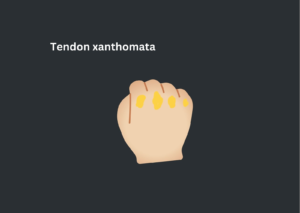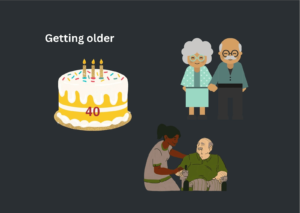High levels of cholesterol can cause heart and circulatory diseases including heart attacks and stroke.
Cholesterol is a type of lipid that is naturally produced in the liver. Every cell in our body uses cholesterol, and it is an essential constituent in our body. Some of this cholesterol comes from the food that we eat. There are two main types of cholesterol: good cholesterol and bad cholesterol. Excessive levels of bad cholesterol might lead to complications. It may clog up the blood vessels in your arteries, which supply blood to your major organs. A heart attack may result from clogged and damaged arteries that provide blood to the heart. A stroke may result if this occurs in the arteries supplying blood to the brain.
There are different types of cholesterol.
| Good cholesterol E.g.: HDL |
High-Density Lipoproteins / HDL cholesterol is known as ‘good’ cholesterol because it gets rid of ‘bad’ cholesterol from your blood vessels. |
| Bad cholesterol E.g.: LDL |
Non-High-Density lipoproteins/ Non-HDL cholesterol is known as ‘bad’ cholesterol because if you have too much of it, it gets stuck to the walls of your arteries. |

What causes high cholesterol?
High cholesterol can be caused by:
| Things you can control | Things you can’t help |
| Eating a lot of saturated or trans fats
|
Ageing
Ethnic background
Family history
|
Symptoms
How can I know whether I have high cholesterol?
High cholesterol has no symptoms. A blood test is the only way to detect if you have it.
A doctor may also suggest you have your cholesterol checked more frequently if you have a family history of high cholesterol. They might also suggest it if you have the following risk factors:
- High blood pressure
- Overweight
- Smoking
- Diabetes Mellitus
However, if you have familial hypercholesterolaemia, you may have visible signs of high cholesterol.
These include:
Tendon xanthomata – swellings made from cholesterol on the knuckles of your hands, knees, or the Achilles tendon at the back of your ankle.

Xanthelasma – small, yellow lumps of cholesterol near the inner corner of your eyelid skin.

Corneal arcus – this is a pale white ring around the coloured part of your eye, your iris.

How to diagnose that you have high cholesterol?
Cholesterol levels vary from person to person, but in general, for a healthy heart, you need a low level of non-HDL and a higher level of HDL.
It is recommended to have your cholesterol levels checked every 4 to 6 years if you’re a healthy adult over the age of 20. You may need to have your cholesterol checked more often if you’re at an increased risk of high cholesterol.
You may also need more frequent cholesterol checks if you have a family history of cholesterol problems or heart attacks at a young age, especially if your parents or grandparents have been affected.
If you are already on medication for cholesterol and achieved the required level, you may check it annually.
If you have high cholesterol levels your doctor will assess the ten-year cardiovascular risk of getting a heart attack or stroke, before deciding on starting treatment.
How do you prepare for a lipid test (Lipid profile)?
You will usually need to fast for 8 to 12 hours. You should not eat or drink anything except water during this time.
Treatment targets and goals
The intensity of lipid-lowering therapy depends on the cardiovascular risk of developing heart attack or stroke and other comorbidities. Therefore, your doctor will decide the dosage and lipid-lowering target levels.
Management and Treatment
It is recommended that everybody adhere to a healthy lifestyle to maintain a desirable level of lipids. When your cholesterol is high and the risk for cardiovascular diseases is high, your doctor will prescribe a drug called ‘statin’, which will suppress the cholesterol production in your body.
More often, it will be atorvastatin, rosuvastatin, or simvastatin.
If your cholesterol level is not under control, what should you do?
- Make sure to take your cholesterol pill daily. If your body’s response to the drug is low and you cannot achieve the required level, other options are available.
- Make sure you continue lifestyle modifications including a healthy diet and exercises, concurrently.
- Diet – avoiding fast food, deep-fried food, and saturated fat; eat more green vegetables
- Exercise – aerobic exercises 30 minutes per day, five days per week (minimum)
Complications
- If your cholesterol remains high, you are at a high risk of developing a heart attack and/or stroke.
- It is essential to continue your medication lifelong according to your doctor’s advice.
Diet and Nutrition
- Have a well-balanced diet.
- You need to eat plenty of non-starchy vegetables and two to three servings of fruits per day.
- Conversely, you should consume fewer foods that are high in saturated fat, sugar, and salt.
- Limit food with high energy content:
-
- Starchy foods: rice, yams, manioc, potatoes, sweet potatoes, etc., flour-based foods (hoppers, string hoppers, pittu, etc.)
- Refined sugars: energy snacks, candy, soft or fizzy drinks, high-sugar tea/coffee, flavoured drinks
- Foods with high-fat content: fried and baked foods, pre-packaged snacks (frozen pizza, pies, cookies, biscuits), fried rice, kottu, cooking oils, and spreads. Limit the use of red meat (pork, beef) and processed meat (sausages, meatballs), prawns, and cuttlefish
- Dairy products: Milk, cheese, yoghurt, and non-dairy alternatives are included in this group. Non-dairy options include soya, rice, oats, nut-based drinks, and yoghurt. Opt for unsweetened and calcium-fortified alternatives where possible. This group does not include butter, cream, and ice cream as they are high in saturated fat. They belong to the category of foods high in fat, salt, and sugar. To make healthier choices, choose lower-fat and lower-sugar options where possible. Substitute whole milk for semi-skimmed or 1% fat milk and choose low or reduced-fat versions of cheese and yoghurts.
- Oils and spreads Unsaturated oils like rapeseed, olive, or sunflower oils are healthier than saturated fats like butter and lard, ghee, coconut, and palm oil. Avoid deep-fried food as much as possible and do not reuse oil that was previously used for deep-frying. Stir-frying and air-frying is better than deep-frying.
Exercise and Physical Activity
- Engage in moderate-intensity aerobic exercise (e.g.: brisk walking, cycling, swimming, and gardening) for 30 minutes a day for at least 5 days every week.
- Engage in resistance exercises 2 to 3 days per week
Prevention
- Lead a healthy life with good dietary habits and exercise.
- Avoid too much salt, oil, and sugar.
- Take regular medications.
- Check your lipids regularly as advised and more frequently if you have a family history.
- Do not stop your medication without medical advice.




 info@slcim.com
info@slcim.com






